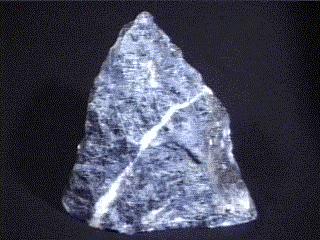
SODALITE
Specimen sod-3
$ 130.00
Dims: 2.5 x 1.8 x 1.6" (6.4 x 4.6 x 4.1 cm)
Wt: 3.73 oz. (105.7 g)
Mount Saint Hilaire, Quebec, Canada
I have never seen a Sodalite piece like this before- our documentation states that it is a variety called Hackmanite. The piece consists of a gray-white host material on which rest many small, sharp crystals. These crystals are rather heavily intergrown in some areas, but are generally in very good condition, showing little damage. Their bladed form definitely does not seem to correspond to the cube-based structure of Sodalite, so maybe the base material is the Hackmanite. This base material contains many indeterminate, tiny black crystals and several broken bits of some equally tiny violet crystals that appear to glow a pale yellow-white under longwave UV light. What is so odd is that none of the material resembles regular Sodalite in any way, especially in color- it is colorless or a gray-white, as opposed to the deep blue of the more common material. I think that I will have to do a few basic tests on this piece, or maybe see if someone at a nearby university can help me... it is very enigmatic.

 Amethyst Galleries' Mineral Gallery MINERALS |

$ 110.00
Dims: 2.6 x 2.6 x 1.0" (6.6 x 6.6 x 2.5 cm)
Wt: 3.90 oz. (110.7 g)
Cerro Sapo, Cochabamba Department, Bolivia
Though not in a definite, isometric-based crystal form, this specimen shows more crystalline form and tendencies than any I have previously seen. It consists of a chunk of blue Sodalite with associated barite and ankerite, and has one cut surface. The surface of the Sodalite is divided up into many smaller, flat surfaces that are too flat and clean to be anything but crystalline. There is even one small surface that shows a definite angle which I belive indicates a twinning plane! It has the classic pale azure-blue coloration of its species, and is dimly translucent around its edges under normal light. Besides the barite and the ankerite, there is no other material present.

Cerro Sapo, Cochabamba Department, Bolivia

SODALITE specimen sod-3
$ 130.00
$ 130.00
Dims: 2.5 x 1.8 x 1.6" (6.4 x 4.6 x 4.1 cm)
Wt: 3.73 oz. (105.7 g)
Mount Saint Hilaire, Quebec, Canada
I have never seen a Sodalite piece like this before- our documentation states that it is a variety called Hackmanite. The piece consists of a gray-white host material on which rest many small, sharp crystals. These crystals are rather heavily intergrown in some areas, but are generally in very good condition, showing little damage. Their bladed form definitely does not seem to correspond to the cube-based structure of Sodalite, so maybe the base material is the Hackmanite. This base material contains many indeterminate, tiny black crystals and several broken bits of some equally tiny violet crystals that appear to glow a pale yellow-white under longwave UV light. What is so odd is that none of the material resembles regular Sodalite in any way, especially in color- it is colorless or a gray-white, as opposed to the deep blue of the more common material. I think that I will have to do a few basic tests on this piece, or maybe see if someone at a nearby university can help me... it is very enigmatic.


sod-3 ($130.00)
Mount Saint Hilaire, Quebec, Canada

SODALITE specimen sod-4
$ 45.00
$ 45.00
Dims: 3.0 x 2.1 x 1.0" (7.7 x 5.3 x 2.6 cm)
Wt: 4.42 oz. (125.2 g)
Davis Hill area, Bancroft, Ontario, Canada
This hand specimen consists of a piece of "Hackmanite", a variety of Sodalite. It is massive and basically white in color, though a few areas show a definite pink tinge. This pink tinge is actually caused by exposure to shortwave ultraviolet light, and will likely fade in white light. While bathing the piece in UV light, it glows a bright pink color.
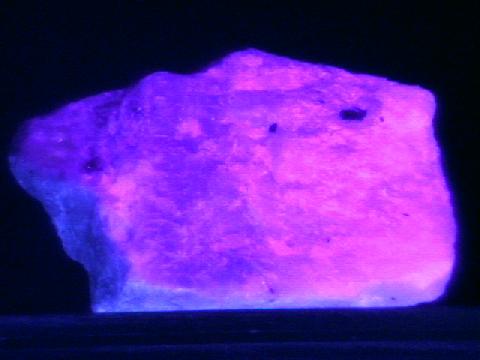

sod-4 ($ 45.00)
Davis Hill area, Bancroft, Ontario, Canada

SODALITE specimen sod-6
$ 32.00
$ 32.00
Dims: 1.5 x 1.4 x 0.6" (3.8 x 3.5 x 1.6 cm)
Wt: 20.5 g
Davis Hill area, Bancroft, Ontario, Canada
This large thumbnail specimen consists of a chunk of massive Hackmanite, a variety of Sodalite. It has a very noticeable pink coloration in one area that fades to white at the opposite end of the piece. When exposed to longwave UV light, it glows a rather bright pink-red coloration. Such exposure is the cause for its pink color- this color may fade in sunlight, but indoor lighting seems to have little effect on it. It is the only piece that I have seen so far where the color change from white to pink has lasted for more than 3 hours.


sod-6 ($ 32.00)
Davis Hill area, Bancroft, Ontario, Canada
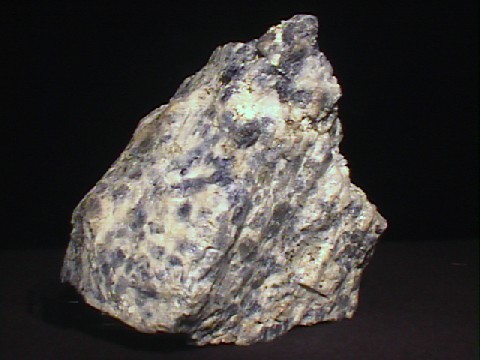
SODALITE specimen sod-7
$ 35.00
$ 35.00
Dims: 3.1 x 2.8 x 2.5" (7.9 x 7.2 x 6.3 cm)
Wt: 11.2 oz. (319 g)
(undetermined)
This rather odd cabinet specimen consists of a large chunk of a white feldspathoid matrix in which rest countless small crystals or nodules of Sodalite. All have a color that ranges from deep blue to gray and a pearly luster. Some definite, flat faces are visible. As this mineral has only poor cleavage that is not often seen, I am relatively sure that these are crystalline faces; examination with a loupe substantiates the previous statement. Some of the tiny crystals that line open crevices even show translucence or dim transparence.

sod-7 ($ 35.00)
(undetermined)

SODALITE specimen sod-8
$ 30.00
$ 30.00
Dims: 4.3 x 2.1 x 1.9" (10.9 x 5.3 x 4.8 cm)
Wt: 7.3 oz. (208 g)
(undetermined)
The feldspathoid matrix of this cabinet piece holds countless crystals and/or grains of Sodalite. These bits do not generally exceed 0.3" (8 mm) in diameter and appear to show definite crystal faces, as sodalite tends to have poor cleavage. All have a color that ranges from gray to pale blue to deep blue, and their luster is generally pearly. Some of the more exposed Sodalites that line open crevices have the deepest blue color and appear to be nearly transparent. They may well be accompanied by other feldspars or related minerals.

sod-8 ($ 30.00)
(undetermined)
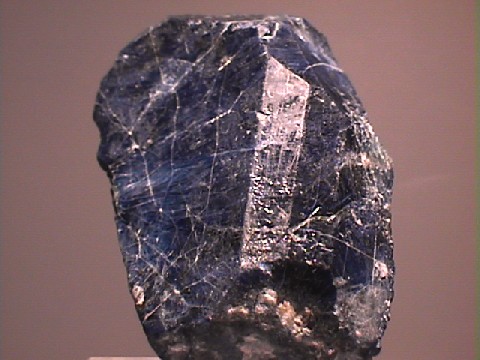
$ 90.00
Dims: 1.9x1.3x0.6" (4.8x3.4x1.5 cm)
Wt: 1.0 oz. (28.1g)
Badkhshan, Afganistan
It's a crystal! Ok, it is not complete, and it has considerable damage, but sodalite crystals are rare. This crystal fragment has 8 faces visible, and is superficially opaque as is most massive sodalite. However, I noticed a bright blue glow from one spot on an edge, and the back (fractured) surface is somewhat sparkly and a deep blue color. Under a loupe, much of the crystal is translucent, and there are some transparent areas that sparkle an intense blue color. You do need a loupe to appreciate this unusual specimen of sodalite.

Badkhshan, Afganistan

SODALITE specimen sod-9
$ 45.00
$ 45.00
Dims: 5.5x3.6x0.3" (13.9x9.3x0.8cm)
Wt: 5.0 oz. (143g)
Lovozero, Russia
This is impressive - a specimen of hackmannite, a variety of sodalite. What makes it so special is that when it is exposed to long-wave ultraviolet, it fluoresces a bright yellow, AND CHANGES COLOR FROM WHITE TO CHERRY RED! Exposure to bright lights (or time) converts it back to the original color. Just about half of this slab is hackmannite, which is normally a translucent white (colorless and transparent in thin sections). While there is no hint of crystal shapes, this is one of those "must have" specimens.


sod-9 ($ 45.00)
Lovozero, Russia
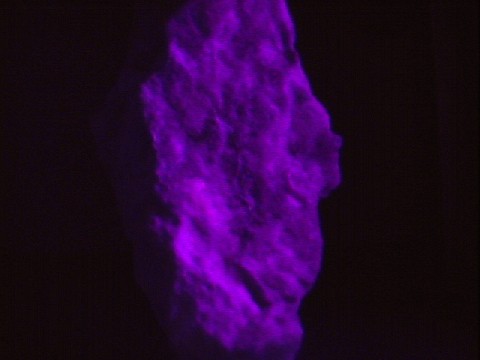
SODALITE specimen sod-10
$ 36.00
$ 36.00
Dims: 3.9x2.7x1.1" (10.0x6.0x2.8cm)
Wt: 6.17 oz. (174.5g)
Lovozero, Russia
This hand specimen is hackmanite, a variety of sodalite. It fluoresces a bright yellow under long-wave UV, and turns pink to almost cherry red! Then, time or exposure to bright lights returns it to the original translucent white. The specimen has been broken from a larger piece, and shows crystal tendencies in cleavage or fracture planes. Hackmannite is a definite must-have for fluorescent mineral collectors.


sod-10 ($ 36.00)
Lovozero, Russia
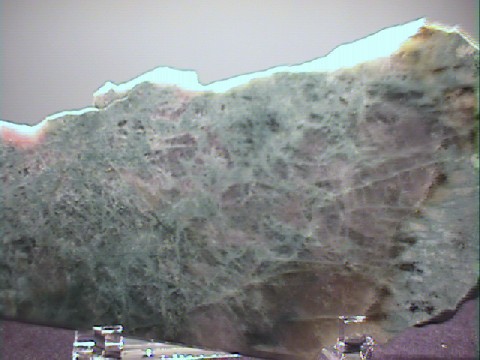
SODALITE specimen sod-11
$ 36.00
$ 36.00
Dims: 4.2x2.6x0.4" (10.6x6.7x1.0cm)
Wt: 3.60 oz. (102.0g)
Lovozero, Russia
This hackmannite specimen has been cut and polished into a slab. It is thin enough to reveal the translucent nature of the portions of the sodalite that will change colors under exposure to UV.


sod-11 ($ 36.00)
Lovozero, Russia
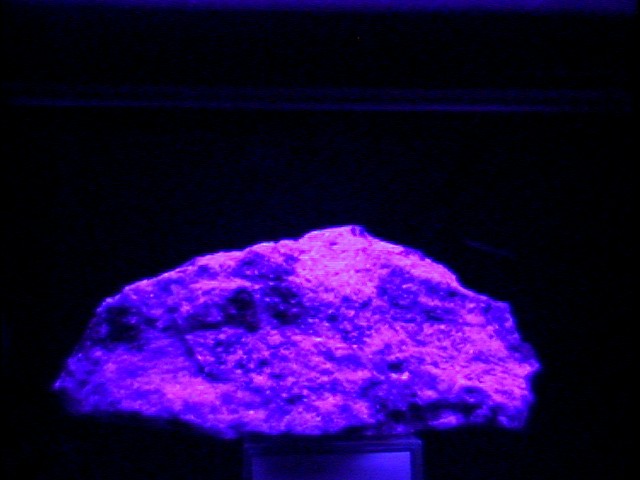
SODALITE specimen sod-13
$ 25.00
$ 25.00
Dims: 3.83x1.59x1.35" (9.73x4.03x3.43cm)
Wt: 4.43oz (125.3oz)
Saami Mountain, Khibini, Russia
This hand specimen of sodalite contains both white crystals and bright purplish-pink ones. Unlike the hackmannite variety, the pink color of these crystals does not fade when exposed to bright light. While none of the crystals is complete, their crystalline nature is evident in the cleavage and fracture lines that may be examined. The sodalite fluoresces brightly under short-wave ultraviolet light. There are additional white minerals present (such as quartz), plus there are numerous black crystals of biotite mica.


sod-13 ($ 25.00)
Saami Mountain, Khibini, Russia
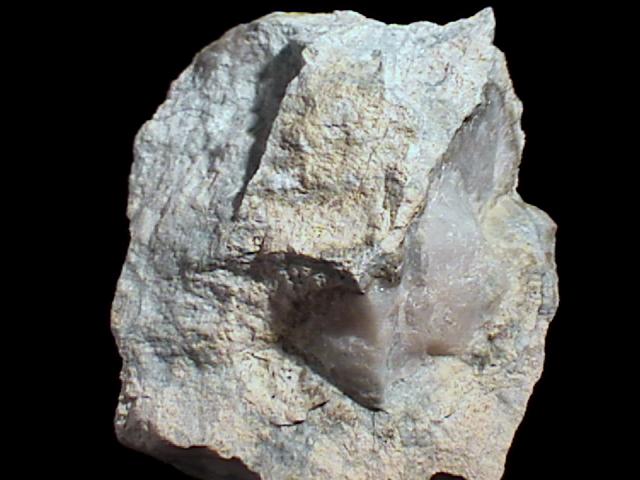
SODALITE specimen sod-14
$ 55.00
$ 55.00
Dims: 3.49x2.62x1.89" (8.85x6.64x4.80cm)
Wt: 10.18oz (288g)
Lovozero, Russia
This rock has a crystal of hackmannite passing through it. Hackmannite is the fluorescent, color-changing variety of sodalite, and this crystal has excellent color change. Normally, the sodalite has a white, translucent appearance, looking a lot like a vein of quartz through the host rock. Under long-wave ultraviolet, it fluoresces a bright yellow, and gradually (a few seconds to a few minutes) changes its visible light color to a bright pink, which fades under a bright light (such as sunlight). The fluorescent image does not do it justice - it really is a bright yellow. Hackmannite is a "must have" specimen for any fluorescent minerals collector.


sod-14 ($ 55.00)
Lovozero, Russia

SODALITE specimen sod-15
$ 135.00
$ 135.00
Dims: 6.87x3.74x0.46" (17.44x9.51x1.17cm)
Wt: 13.33oz (378g)
Lovozero, Russia
This large slab consists of at least 40% hackmannite, the fluorescent variety of sodalite. I believe that the blue mineral is more sodalite, and there are veins and spots of other minerals, probably including calcite. While the blue sodalite areas are opaque, the hackmannite is white and translucent. When exposed to UV light, it glows a very bright yellow (much better than the images imply), and gradually changes (normal light) color from white to pink to red. Exposure to bright light (such as sunlight) erases the pink, leaving the original white hackmannite. The slab has been cut and polished, smooth on one side but a high gloss on the other. The gloss is so good that I suspect it may be a layer of a shellac or similar material, although I can find no indications of overlap or missing coverage to confirm that, and it may indeed be a high polish.


sod-15 ($135.00)
Lovozero, Russia

SODALITE specimen sod-16
$ 110.00
$ 110.00
dims mm=109.92x87.00x9.34
wt g=135
Lovozero, Russia
At least 70% of this slab is a translucent crystal of hackmannite, the flourescent variety of sodalite. Under normal light, it is a creamy bluish-white. Under long wave ultra violet, it glows a bright orange-yellow, and gradually turns into a chery red (visible after the UV is turned off). Exposure to bright light (or a long time) returns the color to normal. The closeup is of the reddish hue.


sod-16 ($110.00)
Lovozero, Russia

SODALITE specimen sod-17
$ 75.00
$ 75.00
dims mm=107.83x64.75x38.46
wt g=330
Lovozero, Russia
It is easiest to identify the hackmannite on this specimen whith a long wave ultraviolet light, which makes it glow yellow-orange and temporarily change to a deep pink color.


sod-17 ($ 75.00)
Lovozero, Russia
